Deepavali
Deepavali: The festival of lights
Rakunathan Narayanan
Deepavali, also known as Diwali, literally means “row or garland of
lights”. Locally, it has been called “The Festival of Lights”. It is
symbolic of victory of good over evil, celebrated by most Hindus the
world over.
It highlights the victory of Lord Krishna, one of the deities of the
Hindu pantheon, over the Demon King, Narakasura. It usually falls around
late October or early November on the new moon day.
Legend has it that Narakasura, the king of demons, had tortured the
common folk. After many years of hardship, the people, unable to bear
the suffering, appealed to Lord Krishna who then declared war against
the demon king.
As he lay dying, the demon king begged for mercy from Lord Krishna
and he asked that the people rejoice and be merry at the anniversary of
his death as a reminder that ultimately evil will never triumph. Little
clay lamps were then lighted as a sign of gratitude to Lord Krishna.
Deepavali preparations
Some Hindus believe that Deepavali is celebrated to mark the return
of Rama, his wife Sita and brother Lakshmana after being banished from
Ayodhya by his stepmother for a period of 14 years.
Preparations start weeks before with the spring cleaning of the home.
New clothes are bought and women take great pains to make cakes,
sweetmeats and other tidbits, the favourite being murukku.
Hindus also believe that departed souls return during this time. So,
favourite foods of the departed along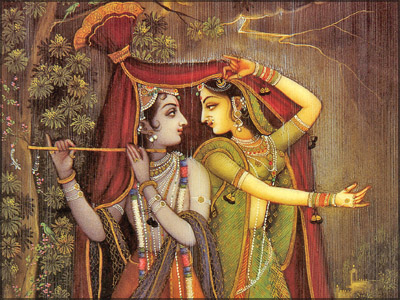 with new clothes are placed on
banana leaves before the photographs of the departed and prayers done. with new clothes are placed on
banana leaves before the photographs of the departed and prayers done.
On Deepavali day, early in the morning, the Hindus will have the
traditional oil bath.
The body is rubbed and massaged from head to toe with gingelly oil
that is extracted from fermented sesame seeds. When all the members have
had their bath and don their new clothes, special prayers are held at
the family altar.
Decorative designs or rice flour paintings with intricate designs
usually done by womenfolk on the floor at the entrances of homes. Hindus
also make it a point to visit temples early in the morning to receive
the blessings of Lord Krishna and his wife the Goddess of Wealth.
Then it is time for either visiting friends or receiving them. At
night, children play with sparklers and are allowed to light clay lamps
and display them along the window ledges or doorways.
The story of Deepavali
This Diwali which leads us into Truth and Light symbolises that
age-old culture of our country which teaches us to vanquish ignorance
that subdues humanity and to drive away darkness that engulfs the light
of knowledge. Diwali, the festival of lights even to-day in this modern
world projects the rich and glorious past of our country and teaches us
to uphold the true values of life.
The word ‘Diwali’ is the corruption of the Sanskrit word ‘Deepavali’
- Deepa meaning light and Avali, meaning a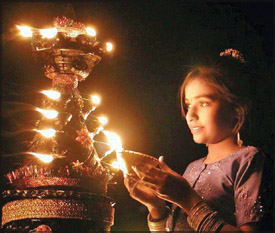 row. It means a row of lights
and indeed illumination forms its main attraction. row. It means a row of lights
and indeed illumination forms its main attraction.
Every home - lowly or mightly - the hut of the poor or the mansion of
the rich - is alit with the orange glow of twinkling diyas-small earthen
lamps - to welcome Lakshmi, Goddess of wealth and prosperity.
Multi-coloured Rangoli (the design of the background of this page is
of rangoli, also people drawn with rice flour on the grounds into their
house, rangoli) designs, floral decorations and fireworks lend
picturesness and grandeur to this festival which heralds joy, mirth and
happiness in the ensuring year.
This festival is celebrated on a grand scale and is looked upon
mainly as the beginning of New Year. As such the blessings of Lakshmi,
the celestial consort of Lord Vishnu are invoked with prayers. Even
countries like Kenya, Thailand, Trinidad, Siam and Malaya celebrate this
festival but in their own ways.
This Deepavali festival, it is surmised dates back to that period
when perhaps history was not written, and in its progress through
centuries it lighted path of thousands to attain the ultimate good and
complete ecstasy.
The first day is called Dhanteras or Dhantrayodashi which falls on
the thirteenth day of the month of Kartik. The word ‘Dhan’ means wealth.
As such this day of the five-day Diwali festival has a great importance
for the rich mercantile community of Western India. Houses and Business
premises are renovated and decorated.
Entrances are made colourful with lovely traditional motifs of
Rangoli designs to welcome the Goddess of wealth and prosperity. To
indicate her long-awaited arrival, small footprints are drawn with rice
flour and vermilion powder all over the houses.
Lamps are kept burning all through the nights. Believing this day to
be auspicious women purchase some gold or silver or at least one or two
new utensils. ‘Lakshmi-Puja’ is performed in the evenings when tiny
diyas of clay are lighted to drive away the shadows of evil spirits.
‘Bhajans’- devotional songs - in praise of Goddess Laxmi are sung and
‘Naivedya’ of traditional sweets is offered to the Goddess. There is a
peculiar custom in Maharashtra to lightly pound dry coriander seeds with
jaggery and offer as Naivedya.
In villages cattles are adorned and worshipped by farmers as they
form the main source of their income. In south cows are offered special
veneration as they are supposed to be the incarnation of Goddess Lakshmi
and therefore they are adorned and worshipped on this day.
A very interesting story about this day is of the sixteen year old
son of King Hima. As per his horoscope he was doomed to die by a
snake-bite on the fourth day of his marriage.
On that particular fourth day of his marriage his young wife did not
allow him to sleep. She laid all the ornaments and lots of gold and
silver coins in a big heap at the entrance of her husband’s boudoir and
lighted innumerable lamps all over the place.
And she went on telling stories and singing songs. When Yam, the god
of Death arrived there in the guise of a Serpent his eyes got blinded by
that dazzle of those brilliant lights and he could not enter the
Prince’s chamber.
So he climbed on top of the heap of the ornaments and coins and sat
there whole night listening to the melodious songs. In the morning he
quietly went away.
Thus the young wife saved her husband from the clutches of death.
Since then this day of Dhanteras came to be known as the day of
‘Yamadeepdaan’ and lamps are kept burning throughout the night in
reverential adoration to Yam, the god of Death.
The second day is called Narka-Chaturdashi or Choti Diwal which falls
on the fourteenth day of the month of Kartik.
The story goes that the demon king Narakasur ruler of Pragjyotishpur
(a province to the South of Nepal) after defeating Lord Indra had
snatched away the magnificent earrings of Aditi, the Mother Goddess and
imprisoned sixteen thousand daughters of the gods and saints in his
harem.
On the day previous to Narakachaturdashi, Lord Krishna killed the
demon and liberated the imprisoned damsels and also recovered those
precious earrings of Aditi. As a symbol of that victory Lord Krishna
smeared his forehead with the demon king’s blood.
Krishna returned home in the very early morning of the
Narakachaturdashi day. The womenfolk massaged scented oil to his body
and gave him a good bath to wash away the filth from his body.
Since then the custom of taking bath before sunrise on this day has
become a traditional practice specially in Maharashtra.
The third day of the festival of Diwali is the most important day of
Lakshmi-Puja which is entirely devoted to the propitiation of Goddess
Lakshmi. This day is also known by the name of ‘Chopada-Puja’.
On this very day sun enters his second course and passes Libra which
is represented by the balance or scale. Hence, this design of Libra is
believed to have suggested the balancing of account books and their
closing. Despite the fact that this day falls on an amavasya day it is
regarded as the most auspicious.
The day of Lakshmi-Puja falls on the dark night of Amavasya. The
strains of joyous sounds of bells and drums float from the temples as
man is invoking Goddess Lakshmi in a wondrous holy ‘pouring-in’ of his
heart.
All of a sudden that impenetrable darkness is pierced by innumerable
rays of light for just a moment and the next moment a blaze of light
descends down to earth from heaven as golden-footed Deep-Lakshmi alights
on earth in all her celestial glory amidst chantings of Vedic hymns.
One of the most curious customs which characterises this festival of
Diwali is the indulgence of gambling, specially on a large scale in
North India.
It is believed that goddess Parvati played dice with her husband,
Lord Shiv on this day and she decreed that whosoever gambled on Diwali
night would prosper throughout the ensuring year. This tradition of
playing cards- flush and rummy with stakes on this particular day
continues even to-day.
The fourth day is Padwa or Varshapratipada which marks the coronation
of King Vikramaditya and Vikaram-Samvat was started from this Padwa day.
Govardhan-Puja is also performed in the North on this day. As per
Vishnu-Puran the people of Gokul used to celebrate a festival in honour
of Lord Indira and worshipped him after the end of every monsoon season
but one particular year the young Krishna stopped them from offering
prayers to Lord Indra who in terrific anger sent a deluge to submerge
Gokul. But Krishna saved his Gokul by lifting up the Govardhan mountain
and holding it over the people as an umbrella.
Govardhan is a small hillock in Braj, near Mathura and on this day of
Diwali people of Punjab, Haryana, Uttar Pradesh and Bihar build cowdung,
hillocks, decorate them with flowers and then worship them.
The fifth and final day of Diwali Festival is known by the name of
‘Bhayya-Duj’ in the Hindi-speaking belt ‘Bhav-Bij’ in the
Marathi-speaking communities and in Nepal by the name of ‘Bhai-Tika’. As
the legend goes Yamraj, the God of Death visited his sister Yami on this
particular day.
She put the auspicious tilak on his forehead, garlanded him and led
him with special dishes and both of them together ate the sweets, talked
and enjoyed themselves to their heart’s content, while parting Yamraj
gave her a special gift as a token of his love and in return Yami also
gave him a lovely gift which she had made with her own hands.
That day Yamraj announced that anyone who receives tilak from his
sister will never be thrown. That is why this day of Bhayyaduj is also
known by the name of ‘Yama-Dwitiya’ Since then this day is being
observed as a symbol of love between sisters and brothers. It became
also imperative for the brother to go to his sister’s house to celebrate
Bhayyaduj.
Gurudev Rabindranath Tagore has so aptly put forth the true
significance of Diwali in these beautiful lines: The night is black
Kindle the lamp of love with thy life and devotion.
The inner significance of Deepavali
Looking at the Deepavali festival from the scientific point of view,
it should be noted that at one time in the distant past, our ancestors
lived in the Arctic region (the polar region). In this region, darkness
prevailed for six months.
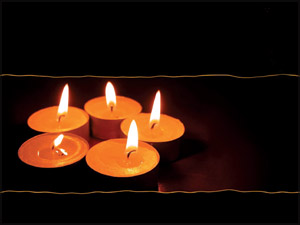 The sun appeared on Mesha Sankranthi day (the sun entering the Aries
sign of the Zodiac). The sun sets in this region on Tula Sankranthi day
(when the sun enters Libra). During the movement between these two
regions, there is an interval of six months. The sun appeared on Mesha Sankranthi day (the sun entering the Aries
sign of the Zodiac). The sun sets in this region on Tula Sankranthi day
(when the sun enters Libra). During the movement between these two
regions, there is an interval of six months.
After the sun sets in Libra, the dark half of the year starts. Today
is the fourteenth day (Chaturdasi) in the month of Karthik. It is the
new moon day (Amavasya).
This month is called Kaumudi. The people in the polar region used to
start lighting their lamps from this day. The lighting of the lamp is
not without other significance. As they would be in darkness for a long
period, they described the lamp that was lit as Nithyajothi (the
perennial light).
Five thousand years ago there were some planets going round the
earth. Some of these planets disappear from time to time. There was one
planet called Naraka which used to go round the earth.
In the course of their orbits, sometimes the moon and the Naraka
planet used to get close to each other. At one time, the Naraka planet
appeared to be approaching close to the earth. This inhabitants of the
earth were filled with dread of the approaching catastrophe.
They prayed to the Lord for diverting the imminent disaster and
saving them. At that stage, Sri Krishna used his extraordinary knowledge
(Prajnana) to destroy that planet. This extraordinary knowledge of
Krishna was termed Sathya.
That is to say, Krishna destroyed the Naraka planet taking
association with Sathya. The denizens of the world started celebrating
that day with lighting of lamps and adoring the Lord who saved them.
That day of the Lord’s triumph was celebrated as a festive occasion.
It was on Deepavali day that Sri Rama’s coronation took place after
his victorious return to Ayodhya from Lanka vanquishing Ravana and his
rakshasa brood. For a long period, Ayodhya had been plunged into darkness (when Rama was in exile in the forest).
darkness (when Rama was in exile in the forest).
In the absence of the effulgent Rama, Ayodhya was a city of darkness.
The forests were filled with light. The return of Rama was hailed by the
people of Ayodhya.
They celebrated the event by the lighting of lamps everywhere.
Today’s festival is marked by other significant features too. This is
the day on which the Lord in His Vamana incarnation sent the emperor
Bali to the nether world after He had got the promise of three feet of
ground (measured by the Lord’s foot) from Bali.
The human being is a composite of man, beast, and God, and in the
inevitable struggle among the three for ascendency, you must ensure that
God wins, suppressing the merely human and the lowly beast.
This festival of Deepavali is to express gratitude at the defeat of
the Naraka (demonic tendencies in man. Naraka is the name for hell. The
Asura, whose death at the hands of Krishna is celebrated today, is
called Narakasura.
He is the personification of all the traits of character that
obstruct the upward impulses of man. He is said to be the son of Bhumi
(the Earth) and he was also called Bhauma.
This is very appropriate. Earthly attachments that lead us down into
the regions of pain and grief. Earthly domain, earthly riches are
powerless before spiritual domain.
What is a festive occasion? It is when great men are born or when
wicked men end their careers of vice. Deepavali celebrated the death of
Narakasura, and how he met his end. He died at the hands of Krishna,
with the Lord standing before his fading eyes.
That is a consummation to be wished for.. On this Deepavali day,
resolve to light the lamp of namasmarana and place it at your doorsteps,
[i.e., the lips], feed it with the oil of devotion, have steadiness as
the wick.
Let the lamp illumine every minute of your life. The splendour of the
name will drive away darkness from outside you as well as from inside
you. You will spread your joy and peace among all who come near you.
The traits of Ravana’s lust, Sisupala’s pride, Kamsa’s hate,
Hiranyakasyapu’s envy are tainting every human heart. Today, we
celebrate the destruction of those traits, collectively personified as
Narakasura, for, they, by their collective effect, lead man into hell or
Naraka.
Those traits are the wild weeds that smother the seedlings of love
and truth of sympathy and service of reverence and communication, which
man seeks to collect in his heart.
The pitch darkness of the new moon night has given place, on account
of the death of Narakasura at the hands of God, to the brightness of the
fair half of the month. Divinity and devilishness compete for the
possession of the mind of the man and pursue him as light and darkness.
The inner significance of Deepavali is to lead man from darkness to
light. Man is perpetually plunged in darkness. Every time he is
enveloped in darkness, he should light a lamp that is ever shining
within him. Carry that lamp wherever you go. It will light your path
wherever you may be.
Deepavali is a festival which is designed to celebrate the
suppression of the ego by the higher self. Man is plunged in the
darkness of ignorance and has lost the power of discrimination between
the permanent and the evanescent. When the darkness of ignorance caused
by the ego is dispelled by the light of divine knowledge, the effulgence
of the divine is experienced.
Today is described as Naraka Chaturdasi. What is Naraka? Whatever is
associated with suffering is called Naraka. KA stands for bad qualities.
NARAKA means human life with bad qualities . Such a life is a hellish
life. How did Krishna deal with Naraka?
Krishna is the Divine, one who attracts by His majestic vibrations.
These vibrations represent the Life Force. The consciousness that
animates the Life Force is known as Prajnaanam, the source of radiation.
When radiation and vibration are active in the human body, you have the
whole human being.
The bad qualities in man in the form of Narakaasura, have to be
destroyed. Krishna came to destroy these bad qualities. He enlisted the
aid of Sathyabhama, who represents the bearer of Truth. This means that
with the help of Truth, Krishna destroyed the bad qualities. On the
Deepavali day, people should pledge themselves to get rid of the bad
qualities.
The true spirit of Deepavali
Diwali is a festival that is traditionally associated with lights,
new clothes and lots of yummy sweets to eat.
But like all other things the fast paced life has started affecting
our festivals too. Sweets that were earlier prepared at home are now
ordered from sweet shops. Buying new clothes was considered special but
now with everybody shopping for clothes ever so often, that aspect too
is overlooked.
“In the olden days people used to start preparing sweets much in
advance and going over to a friends or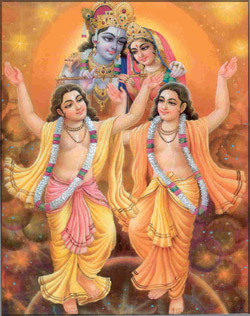 relatives house was something to
look forward to. Today due to nuclear families and both the partners
working, ordering sweets from outside is much easier than making them
yourself,” rues Nanda a North Indian in her mid 50’s. relatives house was something to
look forward to. Today due to nuclear families and both the partners
working, ordering sweets from outside is much easier than making them
yourself,” rues Nanda a North Indian in her mid 50’s.
These days with most of the people being weight conscious exchanging
sweets is pass‚. Gifts of crystal, household articles, and things of
utility are more the order of the modern day.
Another change that has come over the years is that the list of
people to whom the Diwali gifts have to be sent has become longer and
couples find it difficult to handle all of them personally.
They finally resort to sending the gifts with their drivers or office
staff thus losing out on the personal touch. Another social change
noticed is in the way of celebrating Diwali. Exchanging sweets and
bursting crackers is no longer the mode of celebration.
Says Ria, “For the last two years I’ve been sending the funds that I
had earmarked for Diwali gifts and crackers to an orphanage. Initially
both my sons were against it as they felt that they were being deprived
of the pleasure of bursting crackers.
So I decided to involve them too. I took them along with me when I
went shopping for the notebooks and shoes needed in the orphanage. On
Diwali day I took them along when I went to distribute the things.
Believe me the joy I saw on the faces of those children was the best
gift my children and I got.
This year my children are looking forward to the annual Diwali
shopping. In fact my elder son has already rung up the administrator of
the orphanage to find out what all they need.
This idea was really liked by my friends who have decided to
contribute too. So this year we will be able to buy more things for the
orphanage and relief centre.”
Far away from home many families prefer to party with friends to
celebrate Diwali.
Though Diwali is essentially a festival of lights and fireworks many
people are opting out of this kind of celebration as bursting crackers
pollutes the atmosphere and the cracker industry is basically a child
labour dominated industry.
So this year are you game for celebrating Diwali in a different
manner and lighting the life of the underprivileged?
The Hindu
Deepavali recipes
SWEETS
Baadhusha
 Make sugar syrup by mixing 150g sugar with equal amount of water and
cooking for about five minutes. To 100g of ghee add a pinch of salt, a
pinch of baking soda and mix until bubbles appear. Make sugar syrup by mixing 150g sugar with equal amount of water and
cooking for about five minutes. To 100g of ghee add a pinch of salt, a
pinch of baking soda and mix until bubbles appear.
Add 100g of flour to this and mix by sprinkling water in steps so
that it becomes soft. Make this into uniform balls and flatten it
lightly on both sides.
Deep fry this in oil and when it is cooked, put it immediately into
the sugar syrup for about five minutes and then remove it on to a plate.
Repeat the procedure with all the balls. You can decorate it on top with
grated coconut.
*********************
Palgova
Boil one litre milk and cook till it is reduced to half the quantity.
Add 250gms sugar and continue cooking stirring constantly. When the
mixture is thick, add 125 gms ghee in small quantities, and stir till
the mixture leaves the sides of the pan. Add two cardamom powder and a
pinch of edible camphor (optional). Spread on greased plate and leave to
cool .Cut into squares.
*********************
Gulab Jamoon
Make guava as described in palgova but without sugar. To 1/4 kg of
this, add 4 tsp of maida and mix into a soft smooth paste. The mix
should not be too loose or too tough. Roll them into uniform balls and
keep aside.
Mix 4 cups of sugar and 4 cups of water and heat in a low flame until
the mix becomes thick but not sticky. Add 1 tsp of kesari powder, 1 tsp
rose essence and cardomom powder and keep in low heat.
Meanwhile, deep fry the balls in boiling oil stirring them until they
turn golden brown uniformly on all sides. Then add it to the sugar
syrup. Leave it for about one hour to soak. Now jamoon is ready.
Refrigerate
*********************
Badam Cake
 Almonds - 1 cup, very finely powdered sugar - 1 cup, ghee - 2 tsp Almonds - 1 cup, very finely powdered sugar - 1 cup, ghee - 2 tsp
Soak the almonds for an hour. Drain. Remove the skin and grind into a
thick smooth paste adding minimum water. In a thick vessel, mix sugar
and 1/4 cup water and heat.
When the sugar is completely melted, add this paste and cook this for
five minutes. Add ghee and remove from fire. Pour it on a large palate
and smoothen the surface of the mixture with a roller. Then cut with a
knife by drawing parallel lines in the form of cubes.
*********************
Boondi
Boil 1/2 cup sugar and 1 cupwater together. Add a tbsp. of milk to
bring up the scum. Remove scum and boil liquid till the syrup is sticky
between the fingers. Keep side, but keep warm for use. Make batter with
1 cup of gram flour, which should not be too thin. The batter should
evenly coat the back of a spoon when dipped in it.
Heat ghee, hold perforated spoon a little above the hot ghee, pour
some batter on the spoon. Tap very lightly at edge of spoon to allow
small droplets to fall in the ghee.
Pour back remaining batter and wipe spoon. Stir the boondis in the
ghee gently and fry till crisp but not brown. Drain and put into the
syrup. Keep for 3-4 minutes before draining from the syrup. Spread on a
wide plate, add cardamom powder, almonds and mix gently. Cool completely
and loosen the boondi with finger till each droplet separates. Store in
airtight container.
*********************
Sego payasam
Sego-50g, sugar - 1 cup, milk-2 cups(thick), cardomons - 4 (powder
finely), cashewnuts - 10, ghee - 4 tsp
Roast sego in 1 tsp ghee. Mix 1/2 cup milk and 1/2 cup water and
bring to boil. Add sego and cook well until it becomes colourless. Add
the remaining milk and stir. Let it cook well. Now add the sugar and
stir for 2 min. Roast cashews in little ghee. In that same ghee add the
powdered cardomons and add it to the payasam. Serve hot or cold.
*********************
Laddu
 Gram flour - 1 kg, sugar - 1 1/4 kg Gram flour - 1 kg, sugar - 1 1/4 kg
Prepare Boondi. Make sugar syrup by boiling 1:1 Sugar and water for
about five minutes. Add a pinch of kesari powder to this syrup. Drop the
boondis into the sugar syrup and mix well.Roast 100g cashews and 25g
raisins in ghee and add it to the mix.
Also add 20 cardomons and 25g kalkandu (sugar candy) and mix well.
Wait until the mixture cools down to a temperature where the hand can
withstand the heat. Now make into even balls by pressing lightly with
hand. Allow to cool.
*********************
Jilebi
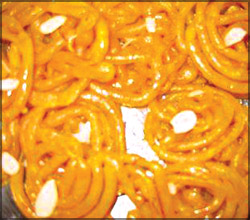 Sugar syrup: Heat sugar and water(1:1) and any essence if preferred
until it becomes thick. Sugar syrup: Heat sugar and water(1:1) and any essence if preferred
until it becomes thick.
Soak urud dal for 1/2 hour and grind it into a thin soft paste. Pour
this paste in a thick plastic cover and make a small hole at its bottom
corner. Heat oil in a fry pan and squeeze the paste into the oil in the
form of tubes and fry until fully cooked. Remove this from oil and drop
into sugar syrup for 2 minutes and then remove.
SAVORIES
Mixture
 Mix Omappodi - 250 g and Boondi - 250 g. Fry 150g peanuts, 50g Aval,
1/4 cup copra bits, in oil until they begin to smell and add it to
boondi-omappodi mixture. Fry six red whole peppers in a little oil and
powder it coarsely and add it to the mixture. Add 2 tsp ghee and mix all
the items well. Store in air-tight containers. Mix Omappodi - 250 g and Boondi - 250 g. Fry 150g peanuts, 50g Aval,
1/4 cup copra bits, in oil until they begin to smell and add it to
boondi-omappodi mixture. Fry six red whole peppers in a little oil and
powder it coarsely and add it to the mixture. Add 2 tsp ghee and mix all
the items well. Store in air-tight containers.
*********************
Hand murukku
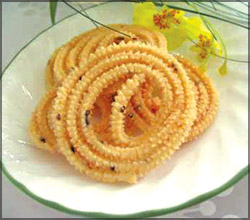 Rice - 1/2 kg,(Soak in water for 2 hours). Wash and drain fully.
Spread it on a large piece of cloth or paper and allow to dry. It should
not dry totally. Grind it into a very nice powder. Sieve this flour. Add
urud powder in the ration 8:1. Rice - 1/2 kg,(Soak in water for 2 hours). Wash and drain fully.
Spread it on a large piece of cloth or paper and allow to dry. It should
not dry totally. Grind it into a very nice powder. Sieve this flour. Add
urud powder in the ration 8:1.
Add 1 tsp salt, 1/4 tsp asafoetida, 2 tsp sesame seeds or cumin
seeds, 4 tsp butter. Mix well adding little water into a soft dough.
Using this dough, make murukkus on a sheet of newspaper(it absorbs the
water) by rolling spirally to get the desired shape.
Grease your hand with coconut oil to get the shapes. Leave it to dry
(it should not dry too much or it should not be too watery). Heat oil in
a frying pan, and deep fry, turning occasionally. Remove the murukkus
when the sound of murukku in oil, becomes silent. These can also be made
using ready-made murukku plates.
*********************
Curd Murukku
 Rice flour - 500 g Rice flour - 500 g
Sour curd - 1 cup
green chillies - 4
salt - 1 spoon
asafoetida - 1/2 spoon
Grind the green chillies finely and mix all the ingredients to form a
thick flour paste. We use curd to make the murukku crisp. Place a large
ball of this flour inside a “murukku mould” and squeeze the mould so
that the murukku drops into boiling oil. Turn over until fully cooked in
boiling oil. If you use good oil and store the murukkus in air tight
containers, it will be good for up to 10 days.
*********************
Thenkuzhal
 Rice flour - 250g, urud powder - 4 tsp, cumin seeds, sesame seeds -
each 1 tsp, salt - 1/2 tsp, asafoetida - 1/4 tsp Rice flour - 250g, urud powder - 4 tsp, cumin seeds, sesame seeds -
each 1 tsp, salt - 1/2 tsp, asafoetida - 1/4 tsp
Mix the ingredients first with a tsp of ghee and then with minimum
water into a thick paste.
Then place a large ball of this in thenkuzhal achu(medium sized round
holes) and squeeze in boiling oil as in curd murukku. |

